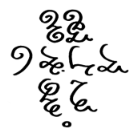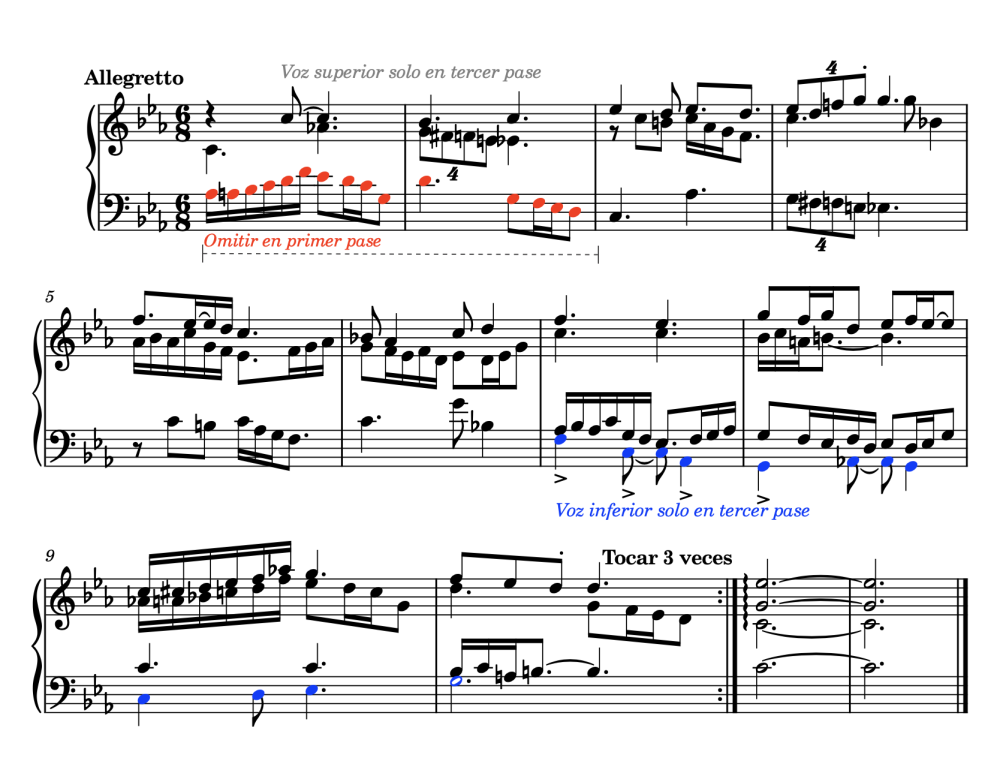All Activity
- Past hour
-
A revised version of one of the earliest fugues I ever finished, back in early December 2019. Given I had only started composing a few months prior to that point, this fughetta was previously riddled with contrapuntal flaws and mistakes, the vast majority of which have all hopefully been corrected while leaving the melodic upper voice almost intact (for the most part). Enjoy! YouTube video link:
- Today
-

Impromptu in G Minor
SergeOfArniVillage replied to SergeOfArniVillage's topic in Piano Music, Solo Keyboard
@Thatguy v2.0 Hey, thanks for dropping by and listening and commenting. I appreciate it! You’re right, a live performance would add a lot. I wrote this piece to be easy to play, with the exception of mss. 80-88: the L.H there does complicates things, but doing “piano drills” on 8 mss of music is super reasonable, imo. I do play the piano, personally! I’ve played off and on for years. -
Oh you notice that fluatando and relationship with b.199! They both resonate with 1st mov's b.401 section. Thx to @chopin I have introduced a more medieval atmosphere here after a Baroque treatment. In fact I'm listening quite some Hisaishi's music now becuase I am watching Hayao Miyazaki's films. Maybe I will notice it in the near future! I love that chord! Such a great description as "sunset-like"! I think it is sad but invites hope in it, which augurs the next section. I like the vivacity of this part, and as you said it's ritual like. The pizzicati on violins playing the chant theme and the cello playing the dance theme, and it is like a internalized ritual in my heart to find myself. And like you said, the pizzicati does sound like percussion instrument here as in a ritual. Oh wow you notice the connection! Here things undone is finally done! What is not understood is finally understood here in an epiphany in the form of snap pizz. This verse is so wonderful. It's one of my philosophy professor's favourite quote and I can immediately feel the beauty and wisdom the moment my professor told me the verse, and I couldn't forget it at all, so I used it here, with the pizz. glissando sounding quite like frog's croaks, or the heart's shake. Although there are two croaks here lol, possibly the first one by a younger frog and second one by an older frog haha. This phrase is added and framed by myself. You are so right to link the crossing of voices with heaven and earth because that's my intention here. It also happens in b.756. I do this because in Chinese I-Ching, the intersect of Heaven and Earth means auspicious, because there is interaction between them and hence the Qi (air) can constantly flow. I think I somewhat feel Tao myself. You can call this act as "escaping from reality", but I cannot undermine what I feel. I know wars and tragedies are happening, but my feeling and hope and reflection for transcendence should not be undermined. Exactly!!!!!!!!!! Like Lao Tsu said, what is speakable (道) is not Tao (道), and this already sounds paradoxical, at least in appearence. But all this paradox are just the appearence, if you get deeper, all those paradoxes and contradictions can be eradicated, just like the tritone of G-flat major and C major here. I feel like this passage is not composed by me at all, as I am always in awe of its power myself. I feel like I'm never capable of composing this passage. I thank myself for having a walk so I could miraculously write this theme and light up my creative power for finishing this piece. In Heaven or Tao or whatever, everything should be in harmony, and not just a primitive Eden in my opinion. That final recap is so wonderful. Again I think this passage is not written by myself at all. The more playful interlude is a joy after all the realization, and that last rise to heavens is probably inspired by the ending of Chopin's Fantasie in F minor. And I don't know why I end the piece in pizz. gliss, but like you said it is symbolic. Thank you so much for your huge compliments, I am really flattered by it. For me, I am happy I've outdone myself, and I will never be a master and remain a student to those real masters in my whole life. I do have some hard work for this Sextet and I'm so happy I've finished it in a way that even I myself don't imagine its coming. For me viewing the whole Sextet, I would relate it to Milton's Paradise Lost and Paradise Regained which I would want very much to read in the future. The Divine Comedy would also be my goal. And, a secret wish is that I hope the Sextet can match a bit of the momumental level Beethoven achieves in his late quartets. Thank you!!! Henry
-
Hello Pabio @Fugax Contrapunctus, I was and am in awe after receiving such a monumental review. I am so happy and deeply appreciated for that, especially when you point out the philosophical and Chinese references in the piece! I must take my 200% effort to reply to your great review. I know it's gonna be my best movement when I was composing the Return part because I was never this fervent in completing a piece at all. I can work at least 5 hours a day on it without feeling tired at all, and was in a hyper mood in those 18 days I was writing the Return part. Of course after that I was tired for a month or so lol! Yup for me the Lamentoso acts as an awakening call from the idealistic but naive first movement: go look into the reality and the world we are living now, don't live in your own dreams, and that awakens the yearning and sorrow, sometimes passionate like passage near 5:00 or 9:00. Yup F# minor is so great for the passion and sadness. At least for me, I think each keys have their own significance and own special colour. G minor will be too light here and will be much better used by Mozart's two great G minor pieces, the Quintet and the no.40 symphony, while G# minor would not be direct enough as F# minor. One little sad thing is that F# minor takes away the presence of my fav. key C# minor here, but at least they are related keys haha and I'm sure C# minor won't mind. Yup having composed the fugue before the Lamentoso, I deliberately used the head of the 1st subject of the fugue in the transition by the end of the Lamentoso to the fugue! Such a great comparison! To be honest, even I myself don't make this connection until you point it out here! I definitely agree with you here! For me I would want that dissonance to be more crude, just like the world now. Thx for noticing the stretti haha! Also the overlapped subjects at b.317! That C minor section after b.317 is always my fav. climax in the fugue and one of my fav. in the whole Sextet. And yes, the tritone modulation indeed is the cornerstone of the internal coherence, you are so acute on that! Tao can communicate between tritones btw G-flat major and C major, and pain can communicate between tritones between F-sharp minor and C minor. In fact Tao and pain cannot miss one and other, because without any one of them pain or Tao don't exist. Thank you! I use Bach's method here by treating the fugue subject as chorale in b.393-394. I do plan for the return to pentatonic C major because I know after the fugue I have to slowly return to pentatonic, so I have to kind of foreshadow its coming here first to make it less awkward. That arch shared melody of violin actually comes from a very important motive in both the 1st and 2nd movement, it first appears in b.19 in second viola, and in 2nd mov it appears in b.607, but here it's in C major. Yeah the power to return to pentatonic is still here without purification, so it's temporarily defeated in b.418. The rhythmic ostinato on 2nd cello comes from the coda of the 1st mov, b.708 violins, which was noticed by Vince @Thatguy v2.0 and he encouraged me to use more of that in the 2nd mov, so I used them here! Thx to him! The reply would be too long, gonna continue in the next post haha! Henry
-

Moment Musical in A-flat major
Henry Ng Tsz Kiu replied to Henry Ng Tsz Kiu's topic in Piano Music, Solo Keyboard
Hey Peter! Yeah for 1. I think I take it from Haydn because he always does that in the retransition to recapitulation, finishing on V/vi and then go straight to I. For 2. it's random thought haha, given my reputation as a random composer lol! For me I treat b.26-34 as the reappearence of the original theme b.1-9, only changing the first half of the phrase an octave lower and into minor. Also, given my reputation as a composer who loves to use random pauses, I won't let anything to unrandomized my pauses! Yeah the 2nd point is legitimate. For me I just wanna keep everything simplest but at the same time maintain some interest, so I didn't modulate to another key or using augmented six chord. I use bunches of secondary augmented six chords and Nepolitan sixth chords in my ( ) piano piece already so I don't use them here haha, since I don't wanna increase the drama here! Give poor Henry a break! Henry -

Moment Musical in A-flat major
Henry Ng Tsz Kiu replied to Henry Ng Tsz Kiu's topic in Piano Music, Solo Keyboard
Hey My Arjuna, Thx! It IS made in a rush haha, and I wanna stop the children in the other rooms playing lolololol! The piano itself is not clear enough and my phone is as always, crappy and full of tears lol! Henry -

Moment Musical in A-flat major
Henry Ng Tsz Kiu replied to Henry Ng Tsz Kiu's topic in Piano Music, Solo Keyboard
Hi @PCC! For me b.35-42 is itself a contrasting theme but it comes from the reharmonization of the phrase b.10-17, because I just don't wanna repeat without some variations. I wanna keep the piece really simple so maybe I don't invite more keys that I should but I'm quite happy with the final product myself haha. It would be wonderful if you arrange the piece for pipe organ! Thx for listening and commenting! Henry -

Moment Musical in A-flat major
Henry Ng Tsz Kiu replied to Henry Ng Tsz Kiu's topic in Piano Music, Solo Keyboard
Hi @Luis Hernández! Thank you! I like both the choral part and the rest parts haha! For b.13 I might have actually take the treatment of chords in Bach's chorale, since he sometimes just ends a phrase on a dom.7 chord or something. Thx for listening and commenting! Henry -

Moment Musical in A-flat major
Henry Ng Tsz Kiu replied to Henry Ng Tsz Kiu's topic in Piano Music, Solo Keyboard
Yo Vince! Thx! Just hurry in a rush to finish this since I was busy yesterday haha! I would wanna write simpler pieces after the Sextet, since I know now that music doesn't have to be complex all the time. Henry -
Hey Pabio @Fugax Contrapunctus, I really love this and your trying to employ your already perfected counterpoint to other style of music. Although I have read from Taruskin's Music History book that counterpoint without tonality would be not too meaningful without the rules for dissonances and its resolution, but it is clearly not correct here. Given your ultimate care for preventing clashing dissonances, I find this one actually quite melodious and even tonal, or at least pan-tonal. It definitely reminds me of the great Fugue in the 1st movement of Bartok's Music for Strings. Like you said the music can go on and on, and I would prefer a non-tonal sound ending actually! Thx for sharing! Henry
-
Hi Luis @Luis Hernández, This one is amazingly composed and looks very wonderful. Your post is wonderful too. Bach's interest in his late period into canons is always wonderful and so glad he did that. Thx for sharing your music and post! Henry
-
I just finish watching the animation Flow this morning and gosh, the film is so amazing and philosophical. I enjoy the overall impressionistic and New music like style film music in the film which perfectly fits what the film wants to tell us. The film music itself is spectacular because it's also done by this film's director. The director does almost fxxkingly everything in the film: Direct, Screenplay, Producer, Cinematography, editing, and even the music is composed by him!! Below are some of the soundtracks I love: This one is great with its dissonance. Wonderful color and climax. This one is used in the climax of the film and its transcendental nature immediately reminds... my own Sextet LoL??!! Both are great! I watch this because @Mooravioli recommends it to me. Thx bro! Henry
-
.thumb.png.8b5b433a341551e913a34392660bc95b.png)
Moment Musical in A-flat major
PeterthePapercomPoser replied to Henry Ng Tsz Kiu's topic in Piano Music, Solo Keyboard
Hi @Henry Ng Tsz Kiu! What a beauty! My favorite parts are: The V/vi in measure 13 which doesn't go to vi but instead segues back into V. The false recapitulation in Ab minor in measure 26. Things I think you could improve on: In measure 30 you seem to rush through the grand pause into the next phrase. But I think what makes such a grand pause like this more effective is allowing the silence and waiting period to really sink in and to do it with more metronomic accuracy. Also, perhaps the figure in measure 29 could be repeated an octave higher after the pause before going back to the recap of the main theme proper. Your harmonic progressions are pretty smooth but very based in common practice. I just felt like the piece could have been more adventurous. Like even though you visit foreign tonal centers in your piece, you do so through very familiar and predictable means. It would be so refreshing to hear you modulate to a new key without using a typical sounding secondary dominant or secondary diminished chord. Perhaps experiment more with secondary augmented 6th chords? Or use more line cliches and chromatic passing chords or chromatic mediants? Nonetheless, I think you did achieve your goals of taking a sort of musical holiday after writing your sextet. Thanks for sharing! -

Does this sound boring?
Atlantis_ replied to Atlantis_'s topic in Incomplete Works; Writer's Block and Suggestions
I agree. I applied way too much gain. I can switch it back tomorrow. I have two different headphones. 1 of them is high-end (Focal Stellia) and makes the sound more spaced and "even"; even with the high gain. Then there are the regular headphones (WH-1000XM5) and I have no idea why it sounds so muddled with these. I just heard it. This is all a work in progress, thanks for the feedback! I think I made a few minor improvements but the additional gain undid almost all of it. -
@Atlantis_ I see you just edited your post. Honestly, I think it would be better if you just posted your newly revised version of your piece as a reply to the thread or maybe upload the new version with "ver. 2" in the title so that the newcomers to the topic can listen to the old and new version side by side and compare. What's also frustrating is that I wrote my original review for a piece that people are now unable to hear because you changed it. And I honestly think the original version was better and that's the version that I praised in my review but this new version sounds muddled and unclear and worse than the original imo.
-
expert21 started following Moment Musical in A-flat major
-

Moment Musical in A-flat major
expert21 replied to Henry Ng Tsz Kiu's topic in Piano Music, Solo Keyboard
Kia ora Henry, I quite like the contrast between the 4/4 sections and the 12/8 sections in this piece. However, as I mentioned on Discord, the recording has room for improvement; you said it was recorded in a rush and it kind of shows. Regardless, like the intermezzo, I think this is a very lovely piece. Ngā mihi, Arjuna - Yesterday
-
.thumb.png.8b5b433a341551e913a34392660bc95b.png)
Chorale in 31-tone equal temperament
PeterthePapercomPoser replied to benyamind's topic in Choral, Vocal
Hello @benyamind! I find the harmonies in this otherworldly and rich. The choral soundscape washes over with the thick church-like reverb. For a piece that is comprised of only chords it sure is quite interesting! I admit that on first listen I didn't appreciate it as much as I do now. It's definitely grown on me. Thanks for sharing! -
I must admit, at first I unfortunately hesitated to listen to it, knowing full well this gargantuan masterpiece, your self-termed best movement even in comparison to all of your other masterful works, could and would certainly blow me away in such a manner that trying to capture but the slightiest speck of its brilliance into a proper review would be pointless. Even this was a huge understatement, but now, having listened to it in its entirety and starting to recover from such a transcendental journey this masterwork has taken me through, it would be a waste not to express my utter admiration for this thoroughly complex, incredibly expressive marvel of musical endeavour you have managed to outdo yourself with, even to your own high standards. The solemnity and sorrowfully contained, tragicly yearning character of the first theme, followed by the intermittent protagonism of the cello from 6:00 onwards, all coupled with such a diverse array of accompaniment textures, gives these passages a very passionate and intimate timber which fits quite well with the whole thematic significance of the Lamentoso section. Even with the sheer amount of well-structured passages with enharmonic modulations, the choice of the main key for this first section of the movement is just as fitting: I have some remnants of chromatic synesthesia myself, and the sense of sorrow and despair provided by F-sharp minor in this context is far more intense to me than that of coadjacent keys like G minor or G-sharp minor, making it one of my favourite keys. The imitative build up by the end of the Lamentoso contrasts very effectively with the following passage that ends it right before the fugue. The harmonics in the violins between bars 199 and 202 reminded me of the sonority of the Chinese sheng and bamboo pipes (笙簫), which I find a pretty spot-on idiomatic reference! Now, onto the fugue: what I found most remarkable from the very beginning is the adventurous minor 2nd dissonances between both voices in each entry pair. The computerized performance doesn't soften them enough, but I'm certain an actual interpretation by real, professional musicians would be able to bring out the most delicate subtlety of these dissonances, though given the character, tempo and dynamics of the fugue, I'm not entirely sure whether they are meant to be subtle or not. Either way, real performers would surely make them sound better. The development section of the fugue is as immaculate as it is expressive, and the enharmonic modulation to C minor in b. 266, as well as the soothing return to F-sharp minor in b. 271~272, both serve as a contrasting inflection point for the outstanding stretto passages starting at b. 287 and b. 309. The return of the C minor storm at b. 317 serves as a rather pleasingly recognizable pattern leading to the fugue's climax, and the overlapped inversions of the subject's 2nd motivic cell throughout, though somewhat hidden, are incredibly rewarding to find. The following return to F-sharp minor fully completes the circle, giving this whole alternating passage between both keys one tritone apart the cornerstone of internal modulatory coherence. Following the last motiv cry of desperation in b. 393~394 from the first violin, the unexpected introduction to C major with pentatonic reminiscence all over worked as a rather compelling interlude bridging the gap between the sorrowful tone of the first half of the movement and the buildup towards the climax. The arch-shaped melody on the violins with pentatonic counterpoint underneath was simply superb. The sudden return to tragedy between b. 418 and 424 acted as a reminder of the movements overarching character, without undermining the heavenly order of the previous passage, as well as the selective recapitulation episode between b. 424 and 438, prior to the proper "Return" with the rhythmic ostinato on the 2nd cello and the rising and falling dominant 7th arpeggios on the rest of the voice creating a sense of trance before the final contrast between the rising arpeggio on all voices in C major with its subsequent equivalent in the C-sharp whole-tone scale and the growing tension provided by the repeating 16th-note motif on all other voices for a final return to F-sharp minor and the succinct yet elegant conclusion to the fugue in alternating octaves. As for the religious chant, the alternating sections between romantic molto expressivo passages and the organum pedal points with modal viola melodies and the reoccourring flautando reminiscent of b. 199~202 provide a devout, serene atmosphere evidently reminiscent of a more medieval atmosphere, and the organum parallelum in 4ths between both violas suddenly reminded me of some of Joe Hisaishi's own applications of these techniques. The sonority of the miniclimax between bars 535~538 reminded me of several romantic composers at once, the likes of Tchaikovsky, Grieg and Rachmaninov in a single, sunset-like chord brimming with secretly coalescing influences. The passage beginning at b. 540, with its pizzicato ostinati and the return of the 1st cello as the protagonist of flowing pentatonic melodies, reminded me of Shinto rituals and their deep sacrality. The exploration of timbral polyvalence here is majestic: one struggles to tell whether the modal mixture in pizzicati on the violins sound like metal or wooden percussion, strings or reeds. As the imitation between the cellos grows and the pizzicati thunder at the end, the glissandi and pizzicati in bars 569~571 call back to those between b. 159~160 and 168~169, granting them new meaning and giving the listener a deeper understanding of what they had heard before. I looked up the meaning of the poetic line attributed to Venerable Master Hsing Yun at 25:50, and it certainly provided more context for what was coming next. 春天月下一聲蛙,撞破乾坤共一家 - "A frog's croak under the spring moon shatters the cosmos, revealing we all share one home." This rudimentary English translation hardly captures the boundless beauty and eternal wisdom incapsulated in this verse. The following passages, and the reference to 人於天地之間,天地相交 - "Humans exist between Heaven and earth, where Heaven and earth intersect" add even more meaning to the exchanging and crossing of voices... from this point on I find it hard to even conceptualize and voice the way the Tao speaks through your music, through you. Its all-encompassing power in the middle of an imperfect universe in constant fluctuation, destruction and recreation - the music is just so perfect and at the same time so reflective of all the sorrows, the tragedies, the imperfections of this flawed, impermanent world. The transition from the fresh, flowing character of the whole G-flat major build up to the glory of C major is simply magnificent. The temporary transition to the floral and divine of A-flat major and back to C major through both ethereal and Earth-shattering modulations gives even further meaning to the paradoxical, contradictory appearance of the Tao in contrast to its immanent and unchanging nature. Listening to the inversely rising and rapidly cascading passages of the following return to G-flat major felt like a trance, like momentaneously falling into the eternity of a hypnotic fractal. The last section of this unbelievably awe-inducing climax brings a newly dignified and solemn character amidst the marvels of this reconstitution and recreation painted through music in the highest domes and furthest spheres of Heaven. The themes from the whole piece, the subjects from the fugue return all in harmony. And moving onto the recapitulation of the first theme, now purified and eternal, alternating with the more playful interlude-like passages leading to the finale, one last rise to the Heavens and subsequent cascade back to Earth, unifying them with the last chords and suffusing with Humanity with the subtle yet exceeding symbolism of the last glissando. Naturally, this review hardly makes any justice to the sheer magnificence of this intertextual nonpareil masterpiece. With such a lush abundance of both internal and external references, I must have missed many details which contribute to the greater hole in these first listening experiences. The internal narrative structure is so incredibly diverse one could mentally recall and recreate an entire universe of sound and color with each listen, and still be eager for the next. This being your best movement to date is hardly an overstatement, it's an epic of biblical proportions, almost like a whole symphony in the span of a string quartet movement, like the entirety of Dante's Divine Comedy spanning multiple cultures, histories and traditions all in one single concert. It might perhaps even sound condescending of me to say this, with my short, humble fugues and monolithically Baroque counterpoint which could hardly ever reach the variety, diversity, internal coherence and idiomatic mastery of yours, but truly, you have outdone yourself on so many levels that not acknwoledging said fact would be even worse: my sincerest bravo, Henry. I doubt I could ever forget my experience listening to the world you have crafted within this single movement. You are a true master, and perhaps without a doubt, the greatest of our day and age.
-
I have been reviewing the perpetual or infinite canon technique. It is described here if anyone is interested: https://komptools.blogspot.com/2025/03/canon-infinito-i-infinite-canon-canon.html The truth is that there are not many examples in the repertoire. I'm interested in trying to incorporate the technique in other types of compositions. I have written quite a few, looking for ways to take advantage of the material. So, for example, in this canon I have added additional voices. In the first pass (10 bars) the canonic voice at the lower octave starts two bars later. In a second pass, the first two measures of the lower voice are added, which are the same as the last two measures of the upper voice. This can be repeated in a loop indefinitely. But what I did on a third pass, is to add an upper voice throughout the canon, and a bass voice in the last measures. The compressed score is this. In the attached pdf I have “unfolded” it. Omitir en primer pase = Omit in the first run Voz superior solo en tercer pase = Upper voice only in the third run Voz inferior solo en tercer pase = Lower voice only in the third run
-
Based on two dodecaphonic dodecaphonic series, the first of which was inspired on the same procedure employed by the main dodecaphonic series in Anton Webern's Op. 28 String Quartet (quite a remarkable tone row which can be subdivided both into three identical tetrachords and the same four trichords corresponding to each of the four transformations (original, inverted retrograde, inverted, and retrograde respectively)), this perpetually descending double canon combines both tone rows at different pitches and entry points, perfectly calculated to limit the amount of clashing dissonances (such as major 7ths or minor 2nds). The main difference between the first tone row and the one which inspired it is the fact it can be divided into four identical trichords, like in the case of Webern's own, but the fact that the jumping interval is a perfect fourth instead of a minor third as in the original means it cannot be divided into three identical tetrachords, nor can it be arranged so that one of them forms Bach's signature motif, which Webern specifically places at the beginning of his own series, perhaps as a reference, homage or even a tribute to Master Sebastian. Even though the successive iterations (each one full step downwards from the previous one, covering the octave in a whole-tone scale pattern) could theoretically continue ad infinitum, for example, if using techniques such as Shepard tone, they are supposed to stop once a full octave downwards from the original entry has been covered when played with real instruments, with a tonal-sounding cadence added at the end to give a greater sense of resolution. Enjoy! YouTube video link:
-
PCC started following Moment Musical in A-flat major
-
Moment Musical in A-flat major
PCC replied to Henry Ng Tsz Kiu's topic in Piano Music, Solo Keyboard
Schubert is the answer! (no, really, literally it is there) I understand bars 35-42 is meant to be a hybrid first theme/bridge, personally I feel like the piece could use more of a cadence in the new key instead of repeating the 4 bar phrase an octave higher. Let me see if I can arrange the piece for pipe organ, at least the choral part. -

Moment Musical in A-flat major
Luis Hernández replied to Henry Ng Tsz Kiu's topic in Piano Music, Solo Keyboard
I am not very familiar with Schubert's specific style. But this musical moment does take me back to that pure romantic period without the later great development. I like the contrast between the almost choral part and the rest, which has a melody that has stayed with me. I also like the chromatic bass in some measures, as a cadenza (measure 2, 7, etc). Although the one in measure 13 sounds stranger to me, perhaps because the chord is left in suspense, and resolves into something more unexpected. Something that I think is frequent in these composers. A beautiful piece Greetings. -

Moment Musical in A-flat major
Thatguy v2.0 replied to Henry Ng Tsz Kiu's topic in Piano Music, Solo Keyboard
I love these little pieces you're writing. I think it shows an abundance of craftsmanship with how quickly you're writing AND performing these for us. This reminds me a little of Schubert, but done in your own way to call it your own. Well done Henry! -
PeterthePapercomPoser started following Moment Musical in A-flat major
-
This Moment Musical in A-flat major is the second piece of the four pieces I intend to write for relaxation after finishing the very heavy String Sextet. As the title suggests, I only want to achieve Schubertian simplicity with some contemplation here. The result is somewhat a bit beautiful and contemplative for me. Here is the YT link and pdf for you: 5-4-2025 Moment Musical in A flat Major.pdf This piece is the opposite with the Intermezzo in A, the first piece of the set, as it uses the theme from the 1st movement of my First Piano Sonata and the key and texture of the 1st movement of my Second Piano Sonata. The recording and this video is again made in a rush so the quality may not be good. Hope you enjoy this little piece! Here is the previous Intermezzo from the same set: Henry





